 | E-mail to Birds Korea |
 | KWBS |
in the Region
 | The Oriental Bird Club |
 | BirdLife International (Asia) |
March
March often contains a mixture of dry, cold days (with night temperatures down to 3-4°C, and highs between 10 and 15°C) and occasional milder showery, windy weather.
Most wintering species are still present, but in progressively reduced numbers. Falcated Duck regularly display on reservoirs and ponds, while small numbers of Baikal Teal remain at key sites. Migrant cranes peak in the northwest, as does the Ancient Murrelet migration along the east coast. Small numbers of shorebirds, including early Great Knot arrive, plus Siberian Buff-bellied Pipits and the first leucopsis White Wagtails. Hundreds of Rustic Buntings, Dusky and Naumann's Thrushes move north-east out of China and Japan, along with smaller numbers of raptors and occasional influxes of Japanese Waxwing. Bramblings and Siskins often form large flocks at key migration points. Sunny days tempt Rustic, Meadow, and Yellow-throated Buntings into song.
>March highlights are usually found by carefully searching through gull flocks for taxa like Pallas's Gull, barabensis, cachinanns, or smithsonianus, though Korea's first Japanese Accentor was found in March 2001 in Busan, Korea's first Bar-headed Goose on the Han-Imjin in 2003, and early migrant Red-billed Starlings and a Chinese Blackbird in 2004, and in 2006 Korea's eighth Pallas's (Great Black-headed) Gull - a species that seems to be a regular (though very scarce) winter visitor.
(The following records are a compilation of our own sightings and records sent in by other observers. As well as being posted on the Birds Korea website(s), selected records are also forwarded to other Korean-language birding websites; records of threatened species are arranged and forwarded to Birdlife International and national authorities when appropriate; flag images and records are passed to bodies responsible for their coordination throughout the flyway; and all records sent to us are used to compile annual reports and to support the evolving understanding of the status of many of Korea’s birds.)
Namhan River, March 30
Five male and three female Mandarin Ducks in the Sangjin section of the Namhan River.
Joonam Reservoir, March 28
Waterfowl diversity and numbers have fallen drastically over the weekend. Coots, Shovelers, Pochards, and Tufted Ducks are the only waterfowl that remain in good numbers. This may be partly due to the increased water level at the reservoir and lack of mud flats for dabblers.
Barn Swallow - 2, Bull-headed Shrike - another nest with 4 eggs, Smew - 5 all female, Common Goldeneye - 1, Bean Goose - 78, Greater White-fronted Goose - only 3 left, Grey Wagtail - 1 female
Jungnangcheon river - Namsan, Seoul, March 27
Sadly (and typically), extensive concrete banking work is underway the length of jungnangcheon river, with riverside trees and vegetation visibly removed.
A few remnant winter ducks still, single numbers of Shoveler, Mallard, Pintail, Gadwall, Spot-billed Duck and ca 50 Teal. Grey Heron are suddenly plentiful, and Mongolian Gulls are in distinct pairs now. Among the scattered leucopsis White Wagtails, 2 clear ocularis (grey backs, black chinstraps, and eye-stripes).
Namsan: Jays, Varied Tits and other "commoners" all very vocal in the warm spring weather.
Eocheong Island - Gunsan, March 26

Calmer and milder (with temperatures recovering to reach ca 13C), and increasing signs of early spring migration. On Eocheong, two Chinese Blackbird (one adult male, and one presumed female), a single Pale Thrush and ca 6 "sub-singing" bush warblers (at least two of which were Japanese Bush, with one or more of the others likely Korean Bush), 2 Chinese Grosbeak, 2 Barn Swallow and still ca 4 personata Black-faced Bunting. In addition, the Long-tailed Shrike was still present, as was the confiding Ancient Murrelet, while 2 Grey Heron and an osculans Oystercatcher (first Eocheong record) were new in.
From the ferry back to the mainland, a single Streaked Shearwater was the personal first of the year.

Eocheong © Nial Moores

Eocheong © Nial Moores
Geum River - Eocheong Island, March 25
With rather improved weather conditions, a quick visit to Eocheong Island to look for early migrants. First highlight of the day was a stunning Black-faced Spoonbill watched close for 20 minutes - from the ferry terminal building in downtown Gunsan! The same bird was "twitched" and photographed by Mr. Chai Seung-hoon.
Although the sea-crossing was rather unproductive, some interesting species were found on Eocheong. Birds of note included excellent views of a breeding-plumaged Ancient Murrelet in the harbor; ca 5 saturata Hoopoe; 15 Daurian Redstart and 1 male Red-flanked Bluetail; the personal first Siberian Stonechat (2) of the spring; a Chinese Grosbeak; ca 5 personata Black-faced Bunting; and rarest of all, a Long-tailed Shrike (only the second record of this nationally rare species on Eocheong, and the first of the year nationwide known to Birds Korea).

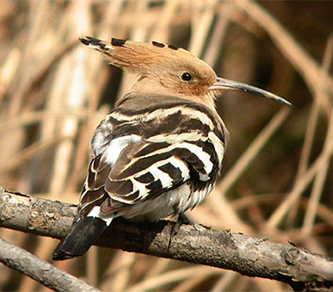

Daebo, March 26
Arctic Loon - 2, excellent views of one bird feeding in the harbor, Pacific Loon - 28, Red-breasted Merganser - 30, Eurasian Sparrowhawk - 1, Far Eastern Curlew - 2, Arctic Skua - one distant bird harassing gulls, Glaucous-winged Gull - 3 near military installation on north end of peninsula, Ancient Murrelet - approx. 35, Rhinocerous Auklet - 1, White Wagtail - several pairs, Blue Rock Thrush - one stunning male
Joonam Reservoir, March 25
Intermediate Egret - 1, Falcated Teal - 200+ on north end of reservoir, Smew - 7, Japanese Quail - 1, White-rumped Swift - approx. 50 feeding high over reservoir, Greater Spotted Woodpecker - 1, Buff-bellied Pipits - several large flocks numbering in the 100's, Bull-headed Shrike - incubating 5 eggs
Seosan, March 25
300 Hooded Crane present near Lake A, and the first 4 Black-winged Stilt back on Lake B.

Jeju, March 25
Three Temminck's Stint: a very early record of a typically scarce migrant.
Nakdong Estuary, Busan, March 23
Short-eared Owl - one feeding in broad daylight, Whooper Swan - only 3 left, Little Ringed Plover - 5, Kentish Plover - 20+, Approximately 1500 distant "peeps" too distant to identify, Far Eastern Curlew - 4, Japanese Lesser Sparrowhawk - 1, Eastern Marsh Harrier - 1, Red-throated Diver - 2 feeding close to shore, Oriental Greenfinch - 14
Upo Marsh, March 24
Eurasian Spoonbill - 14, Baikal Teal - 5, Garganey - 11, Merlin - 1 female, Spotted Redshank - 1, Bean Geese - 400, Good numbers of Shovelers, Pintail, Eurasian Wigeon, & Common Teal on "Upo Marsh". , The other impoundments supported better numbers of Falcated Teal.
Also, great views of an Amur Leopard Cat.
Saemangeum - Geum River, March 24
In cold and very stormy weather (with temperatures struggling up to only 5C, and Force 7 westerly winds), few birds on the Mangyeung, with only 1 White Spoonbill, ca 50 Saunders's Gull, and a few 10s of Curlew, with a single Common Redshank the most unusual. , At the Gyehwa high tide roost (where we were joined by leading local activist Mr. Chu Yong-Gi), a staggering 1 815 Far Eastern Curlew (ca four per cent of the world population and an unexpectedly early mass arrival), with a further 20 Eurasian mixed in, along with one breeding-plumaged Black-faced Spoonbill and the personal first Great Knot (3) of the spring. In addition, at least forty adult Taimyr Gull (all but one still head-streaked and all bright-yellow-legged) in with ca 100 Vega and 50 Mongolians, and one further putative barabensis Steppe Gull, seemed indicative of strong early spring movements. At the Geum barrage, now at least 55 Spotted Redshank.
Saemangeum, mostly Dongjin River, March 23
Stopping at ca 6 points in Saemangeum with Charles Page, a lecturer in photography at the Queensland College of Art (here to gather images for exhibitions on Saemangeum in Australia), produced a range of interesting species, several in rather large numbers.
These included ca 650 Far Eastern Curlew (with one flock of 430), ca 2 000 Grey Plover, ca 1500 Dunlin and 10+ Bar-tailed Godwit (the personal first groups of the season); ca 75 Saunders's Gull; ca 10 000 grey geese (with ca 500+ middendorffi Bean, and one very probable Lesser White-fronted Goose); ca 20 Baikal Teal; 5 leucopsis White Wagtail and 2 Hoopoe; and most unexpected of all a single Tristram's Bunting heard.
Imjingang and Ganghwa, March 20
A cool bright day. A brief stop at the Imjin river just south of Paju: a mixed flock of about 250 Swan Geese and around 100 White-naped Cranes.
On Ganghwado: Near Ongjijun (heading down the south coastal road from the bridge), 14 Ruddy Shelduck with 2 Eurasian Wigeon, and Gadwall, Shovelers, Spot-billed Ducks, Goosanders, and Northern Pintails.
On the mudflats (a couple of random stops) in the Mani-San area along the same coast-hugging highway: 1 Eurasian and 15 Far Eastern Curlews.
Also for March 19 at Imjingak train station: 6 Cinereous Vultures.
Joonam Reservoir, March 20
Lesser White-fronted Goose - 1 still present near nature center, Bean Geese - 11 both subspecies, Falcated Duck - 14, Baikal Teal - 22, Smew - 18, Spotted Redshank - 2, Common Snipe - 2
Sorae Tidal Creek, March 20
A blizzard of Black-tailed Gulls (500+) had gathered at this busy fishing port, with only single numbers of Vega and Mongolian thrown in, as well as 1 Black-headed, and 1 "Taimyr" Gull.
On the slim stretches of mud, 1 Eurasian and 5 Far-eastern Curlew (first of the year for me) gave good close views.
Joonam Reservoir, March 20
Spring is coming - and the Grey Herons are nesting
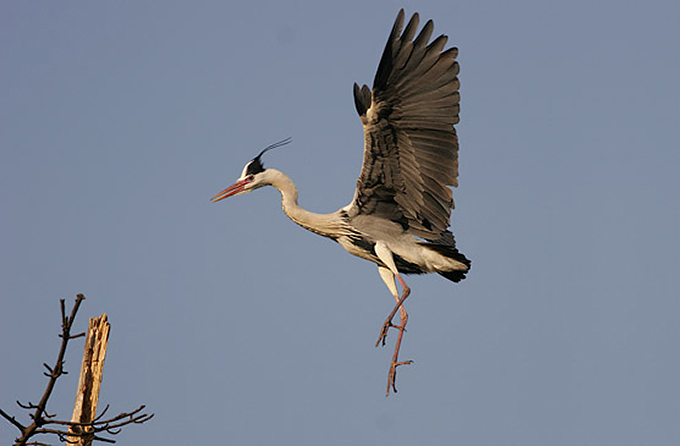
Suncheon Bay, March 19
Common Shelduck - 150, Japanese Quail - 1, Hooded Crane - 73, Eurasian Curlew - 7, Saunder's Gull - 20+ many in breeding plumage
Jogye-San Provincial Park & area, March 18 & 19
Common Merganser - 30+ on Juam Res, Greater Scaup - 8 on Juam Res, Greater Spotted Woodpecker - 1, Gray Wagtail - 3, White Wagtail - building nest under roof tiles near Nagan Folk Village, Brown Dipper - 2, Eurasian Nuthatch - 2, Oriental Greenfinch - 2 Nagan Folk Village
Joonam Reservoir, March 16
Lesser White-fronted Goose - 1, Cackling Geese - 3, Smew - 15, Baikal Teal - 3
Good numbers of Tufted Ducks, Shovelers, Mallards, and Falcated Teal on the nearby reservoir.
Jiri-San NP above Hwaeomsa temple, March 15 - 16
Rough-legged Buzzard - soaring near park entrance, Brown Dipper- several pairs, Jay - abundant, Eurasian Nuthatch - abundant, White-backed Woodpecker - 3 all 2.5 km above the temple and higher, Goldcrest - 1 w/mixed flock, Winter Wrens - singing in abundance, Long-tailed, Coal, Great, Marsh, & Varied Tits - roaming the forest in flocks some containing 30 birds plus!
Suncheon Bay, March 15
Ochre-rumped, Common Reed, & Pallas's Reed Buntings - flocks of hundreds in the extensive reed beds, Ochre-rumped being the least common
Hooded Cranes - 83 in one field. Also one hybrid Common x Hooded, Eurasian Curlew - 25+, Saunder's Gull - 150+, Common Shelduck - 300, Bull-headed Shrike - several pairs
Joonam Reservoir, March 13
Adult Lesser White-fronted Goose, 8 White-naped Cranes, Smew.
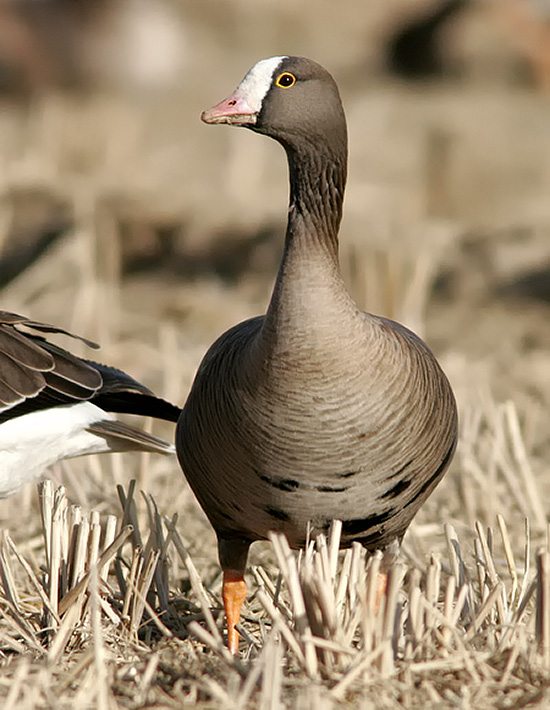
Han River, Seoul, March 13
Seongnae: A very wide and deep stretch of river: 6 Great Cormorants are probably the advance party of many more to arrive later.The usual Great Crested Grebe here, as well as 2 leucopsis White Wagtails. Duck numbers are down, headed by the most numerous Pintail with lesser numbers of Shoveler, Goosander, Pochard and Common Teal. Also, a Common Buzzard at the riverside.
Eunbong: A similar selection of ducks on this narrow, shallow stretch, but complemented by ca70 Tufted Duck and 8 Gadwall, (this site being the most reliable in Seoul to see them.)
Gunsan City and vicinity, March 12

Green Sandpipers were seen in three locations today. At the Geum River Spotted Redshanks have returned. A few thousand Baikal Teal are still present. Far-eastern Curlews were seen first on the 11th. At Okku a single Redshank was seen, as well as two White Spoonbills.
Driving through the Okku area I spotted a Chinese Grey Shrike. It retrieved a mouse from the rice stocks while three excavators worked, moving dirt for the golf course that is being built there.
Seosan, March 12

A morning visit to Seosan produced similar results to the previous week with enormous numbers of Great Crested Grebes at the Southern end of Lake A.This week the duck species included approx 500 Northern Pintail. The number of White/Eurasian Spoonbills had increased to 35.
Waders were represented by a solitary Little Ringed Plover and 2 Common Sandpipers.
At Yong Jong Island there were no waders evident but the highlight were 19 Falcated Teal together with 5 Whooper Swans, Tufted Duck, Pintail,Spot Billed and Mallard at the Southern end of the North Bank.
Han-Imjin and Ganghwa Island (pm), March 11
A bitterly cold wind and temperatures only a little above freezing did not distract from excellent, prolonged views of ca 350 White-naped Crane and 500+ Swan Goose on the Han-Imjin. Also there a single Hooded Crane, 5 Baikal Teal, 3 breeding-plumaged Saunders's Gull, a White-tailed Eagle, and ca 48 Spotted Redshank.
In addition, probably 10 000 Common Pochard were on the Han River, many near Ilsan, while a Rough-legged Buzzard was seen by WS near Gimpo airport.
At Ganghwa, obvious highlight was 15 Red-crowned Crane, while a single Ochre-rumped Bunting (the 163rd species of the tour), in with 4 or 5 Little Bunting was also a good find, as were 8 Far Eastern Curlew, 2 osculans Eastern Oystercatcher and 4 more breeding-plumaged Saunders's Gull.
Daebo (Guryongpo Peninsula) and Angang pm, March 10
In very calm, warm (ca 18 or 19°C) and sunny conditions, excellent views of Rhinoceros Auklet (4 noted) and Ancient Murrelet, and apparently increased numbers of Great Crested Grebe (with ca 160 noted).
At Angang, a once beautiful stretch of near-natural river (which used to hold several Long-billed Plover territories) is now being dredged and concrete-banked along its length, and the only birds of note there were single Little Ringed Plover and Mandarin Duck, and 300 Greater White-fronted Geese in adjacent rice-fields.
Some kms distant, 3 hours of searching finally produced a single Long-billed Plover, and much evidence of early spring migration. Species noted included 2 Short-eared Owl, 5 leucopsis White Wagtail, ca 350 japonicus Buff-bellied Pipit, 20 Little and 10 Pallas's Reed Buntings, 800 Rook and 50 Daurian Jackdaw, and at least 10 eastern Common Gull (the latter typically very scarce inland in South Korea).
Guryongpo Peninsula, March 9
In mild (12C) and largely clear conditions, a very enjoyable day in the field, with good numbers of birds. Some of the more numerous and noteworthy species included Red-throated (30), Arctic (10) and Pacific (120) Loons, Red-necked (20), Black-necked (15) and Slavonian (ca 12) Grebes, and Black-tailed (700) and Slaty-backed (800+) Gulls. Species of further note included 10 Ancient and a single non-breeding plumaged Long-billed Murrelet, 6 Rhinoceros Auklet, 12 Harlequin Duck (including superb views of a pair close-in), the personal first leucopsis White Wagtail of the spring, 13 Glaucous and 2 Glaucous-winged Gull.


Seongsan Po and Halla Arboretum, Jeju, March 8
Spring-like weather, with a high of 15C, and moderate though warm southwesterly winds. Outstanding highlight was prolonged and rather close views of 15 Black-faced Spoonbill (two of which were already largely in full breeding plumage), while other species of note at Seongsan Po included 2 Barn Swallow (personal first of the spring), and the Red-throated Pipit still. At the arboretum, at least 6 Grey Bunting heard (with one very briefly glimpsed by NM).
Jeju City (Seongsanghyeul and Jeju Jeolmul) and Seongsan Po, March 7
Excellent views of a single White's/Scaly Thrush, 12 Pale Thrush, 2 Red-flanked Bluetail, and 11 Chinese Grosbeak...while at Hado ri and along the coast to Seongsan Po, 10-12 Black-faced Spoonbill (roosting largely concealed in reeds), a single Pacific Reef Egret, 5 Japanese Bush Warbler, 3 Black-faced Bunting (including 2 personata based on calls) and a single Red-throated Pipit (perhaps the earliest spring or first wintering record of this species known to Birds Korea).
Songdo Inpia Mudflat, March 6
Clearly the superior of the last remaining, threatened stretches of mudflat at Songdo, with extensive shallows.
I was immediately presented with a couple of surprises: 2 Eurasian Wigeon, the first I have ever seen here, or in the Seoul vicinity: and 6 Eastern Oystercatcher, also personal firsts for this site. 120 Eurasian Curlew are fresh arrivals, and I was pleased to see a group of 6 Grey Plovers, as well as 140 Dunlin hurriedly feeding in a typical revolving flock at the incoming tide. 63 Saunders Gull were mostly in adult breeding plumage, except 6 immature birds - one a dishevelled, limping individual. Also by the tide a lone 1st winter Relict Gull still.
All the other usual suspects present: over 1000 Spot-billed Ducks and 800 Mallard are good counts, as well as 400 Pintail and now 150 Pochard. Only a few Shoveler, Teal, and Black-headed Gulls remain.
Namsan, March 6
A morning walk in Namsan and my Namsan tally was increased by one with a female Bull-headed Shrike. Plenty of Yellow-throated Buntings and Varied Tits singing as if spring is here at last.

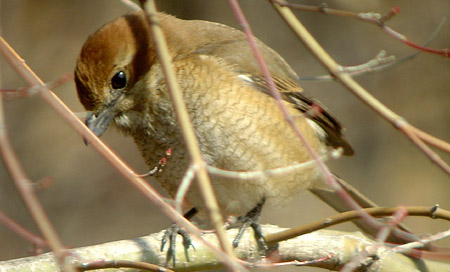
Nakdong estuary and Joonam Reservoirs, March 6
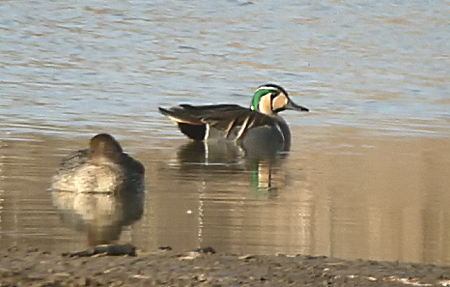
Despite a late start due to a once-in-a-hundred-years snowstorm (dropping almost 30 cm of snow on the city overnight), some excellent birds. On the Nakdong, prolonged views of 3 Relict Gull (one second winter and two first winters), an extremely late second calendar year Steller's Sea Eagle, and five distant Swan Goose, while in woodland at Dadapo, a female Grey Bunting was glimpsed by some in the group.
A late afternoon visit to Joonam reservoirs (where we briefly met bird photographer Mr. Choi Jung-Su) produced excellent views of the wintering Lesser White-fronted Goose and of a single drake Baikal Teal, 3 White-naped Crane, ca 40 Smew and lesser numbers of Falcated Duck.

Suncheon Bay, March 5
Still ca 45-50 Hooded Crane present, as well as 4 Japanese Quail and 2 Chestnut-eared Bunting.
Seosan, March 5
A bitterly cold morning at Seosan with wonderful views of a Peregrine seemingly diving to attack our vehicle. Plenty of variety of duck, Pochard, Tufted, Teal, Gadwall, Shoveler, Spot billed, Mallard, Shelduck, Goldeneye, Goosander, Red Breasted Merganser, Smew but no Baikal Teal or Pintailto be seen.
Seosan A was alive with Great Crested Grebes with the odd Black-necked amongst them. Other sightings included 30 White/Eurasian Spoonbills and a solitary Oriental White Stork. A Goshawk decided to worry the duck and caused flocks of Common Teal to take to the air. Other raptors included Eurasian Sparrowhawk (female), Kestrel, Common Buzzard and a single Upland Buzzard.
In the afternoon a drive along the Han Imjin River was rewarded with a large flock of Crows, Rooksand Daurian Jackdaws. At the same site as last Tuesday there were again 48 White-naped Cranes and 200 Swan Geese.
Seosan - Geum River - Geum River estuary, March 4
On the Geum River, still at least one Lesser White-fronted Goose (in amongst ca 4000 Greater White-fronteds), and ca 200 Baikal Teal, while on the estuary brief scans produced ca 2 900 Dunlin, 200 Grey Plover, 100+ Eurasian and one Far Eastern Curlew, and ca 75 Saunders's Gull.
Seosan, March 3
Find of the day was 2 Oriental White Stork, while other species of note include an estimated 3 000 Great Crested Grebe on the southern end of Lake A (a record count here?), 29 White Spoonbill, 2 Northern Goshawk, a "difficult" Upland Buzzard, and three species of early spring migrant: single Spotted Redshank, Far Eastern Curlew and Hoopoe.
Yangyang Jumunjin, March 2
An enjoyable day in the field, with ca 74 species logged. Species of note included 3 White-tailed Eagle on the river at Yangyang, small numbers of sea-duck offshore (including 15 Harlequin Duck), good views of both Little (10) and Pallas's Reed (20), as well as Rustic (40) and Yellow-throated Buntings (20+), and at least 5 Siberian Accentor. A couple of hours of gull-watching produced the usual spread of Vega (250), Slaty-backed (200) and eastern Common Gull (ca 2000), while other taxa of note included 8 Glaucous, 4 Taimyr, two putative barabensis or eastern cachinnans and a presumed second winter American Herring Gull - the latter showing muddy underparts, a dark greater covert bar, a clean two-toned "Glaucous-type" bill, pale grey mantle feathers and very pale eyes (considered in combination beyond the range of Vega Gull).
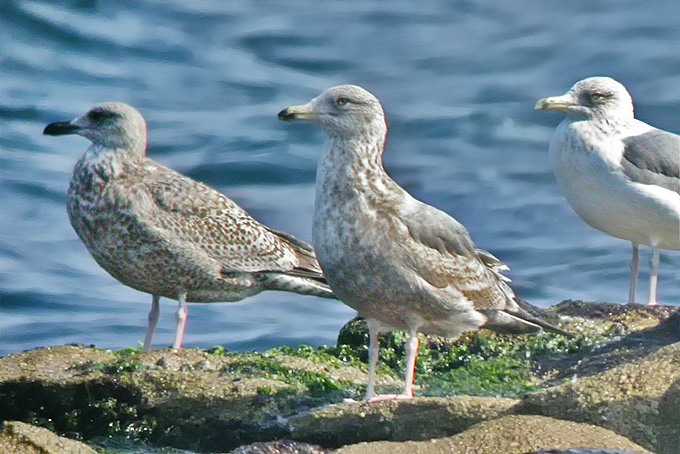
NE River and Hwajin Po to Yangyang, March 1
On the NE River still 4 Scaly-sided Merganser (2 male and 2 female), and now 10+ Mandarin Duck and small numbers of Goosander, along with a single Brown Dipper and perhaps 4 Japanese Wagtail.
At Hwajin Po, happily excellent views of a very late Steller's Sea Eagle (showing dark on the culmen, a weak pale double covert bar and an apparently all off-white tail) in company with 3 White-taileds. Other species of note there and along the coast included 5 Ancient Murrelet, 50 Pelagic Cormorant, 12 Smew and 40 Red-breasted Merganser (as noted first by Einhard, the last was our fourth merganser species of the day!).
Gangwha, March 1
A disappointing visit to Gangwha Island resulted in the only noteworthy sightings of (2) Far Eastern Curlew but the lack of birds on the Island was balanced by (48) White-naped Cranes feeding at the join of the Han and Imjin Rivers at Daedong. The cranes were accompanied by (200) Swan Geese.
Elsewhere along the Imjin River (300) Cinereous Vultures were still in the Jeokseong area.
Flag Sightings:
A Great Knot Calidris tenuirostris was sighted in a flock of 2500 birds by Arthur and Sheryl Keates at: Buffalo Creek Beach, Darwin, NT, Australia 12deg 20min 10sec S, 130deg 54min 40sec E on 26/02/2005 with flag(s) as follows:
LEFT leg: white flag on tibia (upper leg) above orange flag on tarsus, RIGHT leg: nothing/unknown on tibia (upper leg) above nothing/unknown on tarsus
This bird was flagged in Korean Peninsula, approximate co-ordinates 36deg min S, 126deg 40min E, which uses the flag combination White/Orange, sometime since 1998.
The resighting was a distance of approximately 5394 km, with a bearing of 174 degrees, from the marking location.
Plumage described as: 50% Breeding.
Notes from observer: The bird was in advanced breeding plumage (say 40-50%) and was with about 2500 Knots (Red and Great).
What was possibly the same bird was seen by the same observers at the same location on earlier occasions, as recently as 13/2/05.
A Great Knot Calidris tenuirostris was sighted by Catherine McFadden at: between Lee Pt. and Buffalo Ck. Beach, Darwin, NT, Australia 12deg 20min 5sec S, 130deg 54min 13sec E on 13/02/2005 with flag(s) as follows:
LEFT leg: white flag on tibia (upper leg) above orange flag on tarsus, RIGHT leg: nothing/unknown on tibia (upper leg) above nothing/unknown on tarsus
This bird was flagged in Korean Peninsula, approximate co-ordinates 36deg min S, 126deg 40min E, which uses the flag combination White/Orange, sometime since 1998.
The resighting was a distance of approximately 5394 km, with a bearing of 174 degrees, from the marking location.
A Great Knot Calidris tenuirostris was sighted by Arthur and Sheryl Keates at: Buffalo Creek Beach, Darwin, NT, Australia 12deg 20min 10sec S, 130deg 54min 40sec E on 13/02/2005 with flag(s) as follows:
LEFT leg: white flag on tibia (upper leg) above orange flag on tarsus, RIGHT leg: nothing/unknown on tibia (upper leg) above nothing/unknown on tarsus
This bird was flagged in Korean Peninsula, approximate co-ordinates 36deg min S, 126deg 40min E, which uses the flag combination White/Orange, sometime since 1998.
The resighting was a distance of approximately 5394 km, with a bearing of 174 degrees, from the marking location.





